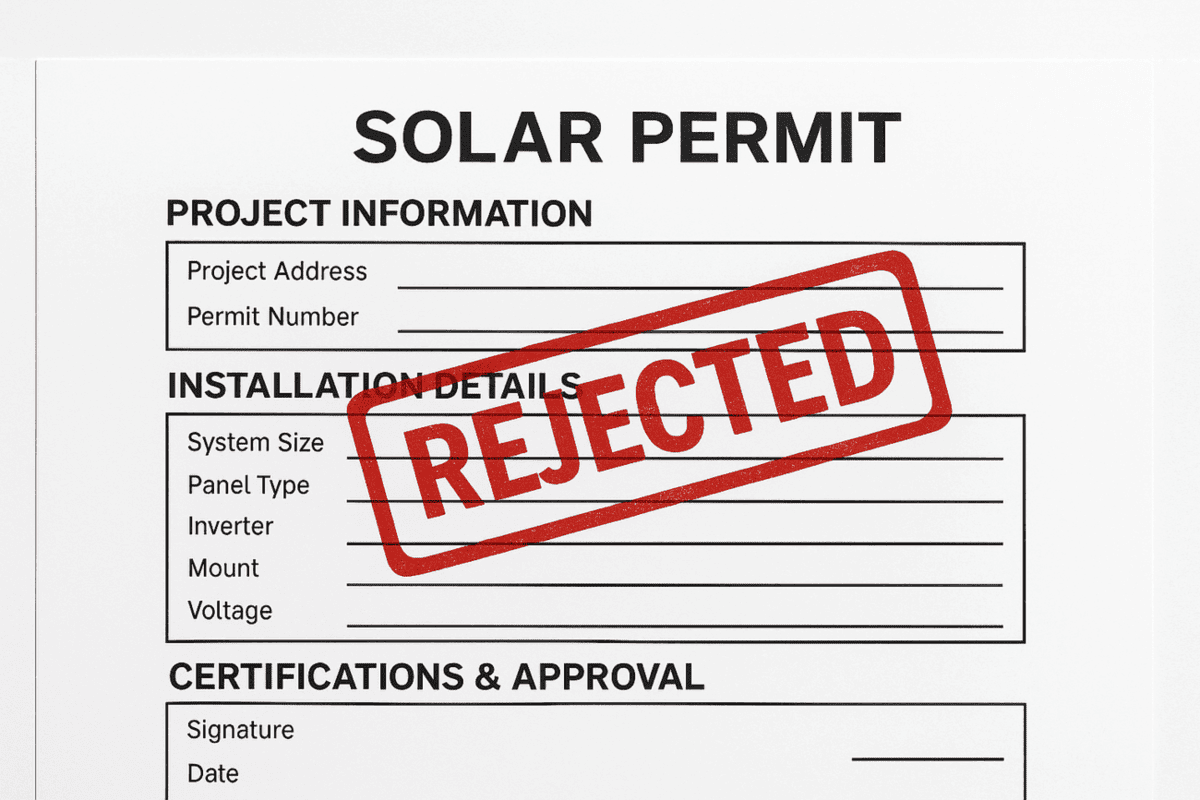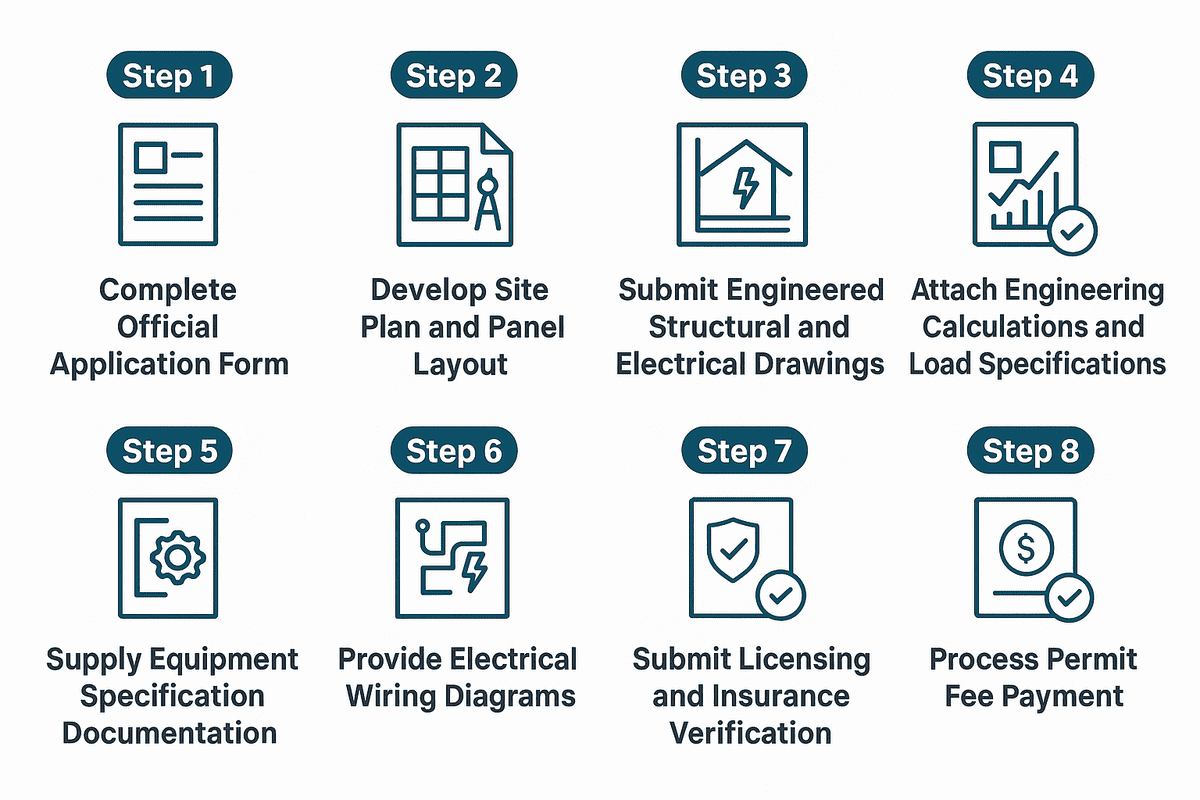

Solar panel permits are mandatory approvals from your local Authority Having Jurisdiction (AHJ) required before installation begins. Most residential permits cost $150-$500 and take 3-7 business days for approval, though timelines vary by jurisdiction. Required documents include site plans, electrical diagrams, structural calculations, equipment specifications, and rapid shutdown plans. Incomplete submissions cause the majority of permit rejections and project delays.
Solar contractors face permit approval delays that can extend project timelines by weeks and increase costs significantly. Understanding solar panel permit requirements eliminates these bottlenecks and keeps installations on schedule.
Solar permitting varies dramatically across states and municipalities. Building codes, fire safety regulations, zoning laws, and utility interconnection standards differ by jurisdiction. Some areas deploy automated platforms like SolarAPP+ for same-day approvals, while others maintain manual review processes requiring 2-3 weeks. Navigating these jurisdictional differences correctly determines whether your project receives first-submission approval or faces costly resubmissions.
This comprehensive guide delivers the exact documentation, timelines, costs, and correction strategies you need to secure solar permits efficiently. Whether you're managing residential rooftop installations or complex commercial projects, this guide provides the specific strategies to transform permitting from a frustrating bottleneck into a streamlined checkpoint.
What you'll learn in this guide:

Solar contractors must obtain a solar permit from their local Authority Having Jurisdiction (AHJ) before beginning any panel installation. Solar panel permit requirements and building codes differ significantly between states and municipalities, making it critical to master local solar permitting regulations. Your project's first-submission approval depends on meeting zoning laws, fire codes, and utility specifications.
Solar panel permit costs directly impact your project timeline and budget in most regions. Some jurisdictions deploy platforms like SolarAPP+ for faster solar permitting, while others maintain manual review processes that extend timelines by weeks. According to the National Renewable Energy Laboratory, streamlining permitting processes can reduce soft costs by up to 30%. Master these jurisdictional differences to eliminate installation delays and avoid budget overruns.
Experienced solar permitting professionals have processed thousands of applications across all 50 states, revealing how precise submissions cut soft costs, eliminate resubmissions, and accelerate project timelines.
Your local AHJ issues a solar permit as formal authorization before any installation begins. This approval verifies both electrical and structural safety, confirming your system meets building and fire code standards. Submit a complete solar permit package containing site plans, wiring diagrams, and equipment specifications.
Secure a solar panel permit for virtually every project type: rooftop residential arrays, ground-mount systems, carport installations, battery additions, and backup generator integrations. Electrical service upgrades connected to solar installations also require permitting.
Approval triggers the installation phase. The AHJ returns post-construction to inspect and verify compliance. Pass this inspection to energize your system and proceed to interconnection.
Each Authority Having Jurisdiction maintains unique checklists, yet most solar panel permit requirements share common elements. Submit a complete solar permit package to minimize review time and prevent costly resubmissions.
Permit reviewers typically require:
Requirements shift based on system type. Residential versus commercial projects trigger different plan reviewers, PE stamp thresholds, and fire department access standards. Ground-mounted systems require foundation specifications, geotechnical reports, fencing plans, and enhanced NEC 690/705 compliance documentation.
For those considering off-grid installations, permit requirements may vary, though most jurisdictions still mandate permits even when not connecting to the utility grid.
Certain municipalities demand supplementary documentation, including Wildland-Urban Interface (WUI) materials demonstrating fire resistance, historic district design reviews for protected area installations, and coastal wind zone calculations for high-speed wind event regions. The U.S. Department of Energy provides additional guidance on renewable energy compliance requirements.
Explore our solar design services to help streamline approval processes and scale operations without compliance delays. Expert permit services ensure accurate, code-compliant submissions delivered on schedule for single installations or portfolio-scale projects.

Follow these standard steps when submitting your solar panel permit application. Requirements vary by jurisdiction, but this sequence applies to most municipalities.
Step 1: Complete Official Application Form. Fill out your municipality's solar permit application, providing system size, installation location, and contractor credentials.
Step 2: Develop Site Plan and Panel Layout. Create a detailed site plan illustrating solar panel placement on the property. Display roof positioning, panel orientation, and required setbacks per local codes. The American Solar Energy Society offers resources on proper solar system design standards.
Step 3: Submit Engineered Structural and Electrical Drawings. Include engineer-stamped drawings when mandated. These documents verify roof load capacity and electrical wiring code compliance.
Step 4: Attach Engineering Calculations and Load Specifications. Engineering calculations prove structural and electrical safety standard compliance. Roof load specifications confirm structural support capacity for the solar panel system.
Step 5: Supply Equipment Specification Documentation Attach specification sheets for solar panels, inverters, and all system components. Verify equipment carries UL listings and meets code requirements.
Step 6: Provide Electrical Wiring Diagrams. Wiring diagrams demonstrate PV system connections to the inverter and home electrical system. Understanding supply-side versus load-side connections is critical for proper diagram preparation. Inspectors require these for review approval.
Step 7: Submit Licensing and Insurance Verification. Most municipalities require contractor license verification and current insurance documentation before approving solar permit services. Professional installation ensures proper licensing and compliance.
Step 8: Process Permit Fee Payment. Each jurisdiction establishes its fee structure. Complete the application by paying the required solar panel permit fee.
Solar panel permit approvals rarely happen instantly. Actual timelines and expenses vary by jurisdiction, with SolarTRACE and NREL data revealing significant national variation. Submit a complete solar permitting package to minimize delays.
According to the International Energy Agency, reducing permitting complexity remains a priority for scaling renewable energy adoption globally.
Applications commonly face rejection for:
Proper wire management and conduit practices help avoid many electrical diagram rejections.
The IEEE Power & Energy Society maintains technical standards that inform many of these requirements.
Commercial projects demand greater complexity than typical residential solar permits. AHJs enforce stricter review standards and require expanded documentation for safety and code compliance.
Trigger thresholds: Larger systems typically mandate professional engineer (PE) seals, special inspections, and detailed fire access lane specifications to satisfy local codes.
Parking canopies: Solar carports and canopies require foundation calculations, wind exposure analyses, and lighting circuit integration. These structures face more intensive scrutiny than standard rooftop installations. Understanding supply-side connections becomes even more critical for commercial-scale projects.
Coordination: Commercial solar permits involve multiple stakeholders. Contractors must coordinate with the AHJ, fire marshal, utility (for pre-application or interconnection approvals), and property owners/landlords to align design and execution requirements. The World Bank tracks global trends in commercial renewable energy deployment and permitting challenges.
Engage experienced solar permit services to keep projects advancing after permit denials. Professional solar permitting services address local solar panel permit requirements and resolve permitting obstacles efficiently.
Professional permitting support includes:
For those considering DIY solar installations, professional permit assistance remains essential even when handling the installation yourself. Resources from Green Building Advisor and ENERGY STAR can supplement your knowledge base.
Securing solar panel permits doesn't have to derail your installation timeline or inflate project costs. Understanding your local AHJ requirements, submitting complete documentation, and avoiding common rejection triggers puts you in control of the permitting process. Whether you're managing residential rooftop arrays or complex commercial installations, preparation remains your most powerful tool for approval success.
Master the essential components every permit reviewer expects: accurate site plans, compliant electrical diagrams, stamped engineering calculations, and complete equipment specifications. Address jurisdiction-specific requirements early, from fire access pathways to rapid shutdown details, to eliminate costly resubmissions and inspection failures.
The solar permitting landscape continues evolving, with platforms like SolarAPP+ accelerating approvals in progressive jurisdictions while traditional review processes persist elsewhere. Stay current on NEC code updates, local zoning changes, and utility interconnection standards to maintain a competitive advantage. When permit denials occur, leverage professional permitting services to quickly identify issues, revise documentation, and coordinate with authorities for expedited reapproval.
Take action now: verify your local solar panel permit requirements, assemble your complete permit package, and submit with confidence. Every day spent waiting for permit approval delays system energization and postpones your client's energy savings. The EPA Green Power Markets program recognizes the importance of reducing regulatory barriers to renewable energy adoption. Apply these strategies to transform permitting from a frustrating bottleneck into a streamlined checkpoint on the path to successful solar installations.
For additional support with your solar permitting needs, contact our team or explore our comprehensive blog resources for more industry insights.
Do I need a solar permit for every solar panel installation?
Yes, virtually all solar installations require permits from your local Authority Having Jurisdiction (AHJ). This includes rooftop residential systems, ground-mount arrays, solar carports, and battery storage additions. Even electrical service upgrades connected to solar installations need permitting approval. The only rare exceptions involve certain off-grid systems in rural jurisdictions, but always verify with your local building department before proceeding. Installing without proper permits can result in fines, forced system removal, insurance claim denials, and complications when selling your property.
How much does a solar panel permit cost?
Solar panel permit costs vary significantly by jurisdiction and system size. Residential permits typically range from $150 to $500, with most municipalities charging between $300 and $400 for standard rooftop installations. Some states cap fees: Colorado limits residential permits to $500 and commercial permits to $1,000. Fee structures include flat rates for residential projects, valuation-based calculations tied to system cost, plan check fees for detailed reviews, and re-inspection charges for incomplete submissions. Commercial permits cost more due to system complexity and additional review requirements. Your solar contractor typically includes these fees in the total project cost.
How long does it take to get a solar permit approved?
Approval timelines depend on your jurisdiction's review process and application completeness. Same-day approvals occur in municipalities using SolarAPP+ or streamlined programs. Standard residential reviews in metropolitan areas take 3-7 business days. Larger commercial systems or jurisdictions requiring professional engineer stamps and fire department reviews extend timelines to 2-3 weeks. Manual review processes in smaller municipalities can take several weeks. Incomplete applications, missing documentation, or code violations significantly extend these timeframes. Submit a complete, accurate solar permit package with all required calculations, diagrams, and specifications to minimize delays.
What are the most common reasons solar permits get rejected?
The top rejection causes include missing professional engineer structural calculations, incorrect conductor sizing on electrical diagrams, incomplete or outdated equipment specification sheets, and improper rooftop fire access pathways. Other frequent issues involve missing labeling plans, absent rapid shutdown details, overlooked battery clearance requirements, insufficient structural anchorage specifications, missing utility service upgrade documentation, and contractor license mismatches or expirations. Many rejections stem from incomplete initial submissions rather than actual code violations. Review your jurisdiction's specific solar panel permit requirements checklist before submitting to avoid these common pitfalls.
Can I submit a solar permit application myself, or do I need a licensed contractor?
Most jurisdictions require licensed solar contractors to submit permit applications and complete installations. While some areas allow property owners to pull permits for their own projects, this approach carries significant risks. Licensed contractors understand local code requirements, maintain required insurance coverage, and have established relationships with AHJs that expedite reviews. DIY permit applications often face additional scrutiny, longer review times, and higher rejection rates due to incomplete documentation or code misunderstandings. Utility companies typically require licensed contractor verification before approving interconnection agreements. Unless you possess extensive solar installation experience and local code knowledge, engage a licensed professional for permit submission and installation.
We are dedicated to providing top-notch solar permit services to homeowners, business owners, DIY, and solar installers. Contact us today.